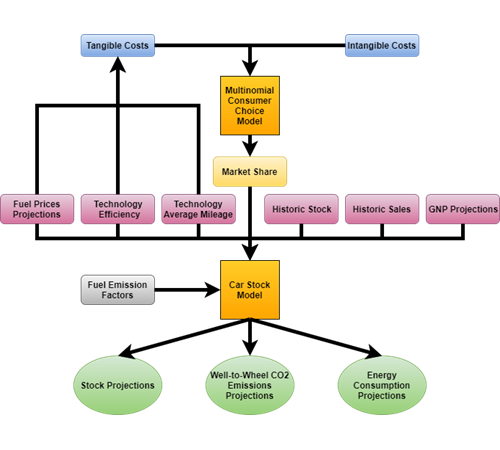Danish Car Stock Model (DCSM) is a simulation model composed of two core components; a socio-economic consumer choice model and a techno-economic CarSTOCK model.
The consumer choice model estimates the influence of several policies on the Danish private vehicle market via a simulation market share algorithm, which has also been employed in the CIMS hybrid energy-economy model (Rivers et al 2005). This algorithm uses the tangible costs (investment cost, maintenance costs, fuel cost and vehicle-related taxes) along with a monetised representation of the intangible costs (model availability, range anxiety, and refuelling infrastructure) faced by the consumers to calculate the market share of a technology in a specific year when competing against a set of technologies. Heterogeneity of private vehicle preferences are accounted for through splitting transport users into 18 segments, divided geographically (urban/rural), by driving profile (Modest Driver, Average Driver, Frequent Driver) and by adoption propensity (Early Adopter, Early Majority, Late Majority), inspired by McCollum et al (2017). Five technologies split into three categories are represented in the model – gasoline internal combustion engine (ICE), diesel ICE, natural gas (NG) ICE, battery electric vehicle (BEV) and plug-in hybrid electric vehicle (PHEV) disaggregated into the classes small, medium, and large (for ICEs, based of engine size) and into short, medium, and long range for BEVs (<125km, 125-175km, >175km respectively). Mulholland et al (2017b) provide a further description of the market segmentation and of the tangible and intangible costs for Denmark. The consumer choice model generates the market shares of the vehicle stock and outputs this result to the CarSTOCK model to determine the impact of policy measures on aggregate stock.
CarSTOCK is a bottom-up model that uses the outputs of the consumer choice model to create stock projections and analyse the net effect of policy measures in Denmark (Mulholland et al 2017b). The CarSTOCK model draws upon detailed Danish statistics (FDM 2017), relating to the composition of private car sales, average mileage, efficiency, and life-time of vehicles with a disaggregation of vintage, fuel type and engine size (vehicle range in the case of BEVs). Using these inputs, it determines the long-term evolution of the private car stock, energy use and related CO2 emissions to 2050 based of the ASIF methodology developed by Schipper et al (2000). The CarSTOCK model has a detailed disaggregation of private car technologies into technology type (in line with those described in the Consumer Choice Model) and 30 vintage categories to represent the evolution of the car fleet.

DCSM model has an ISC license under which it is distributed.
Reference:
Eamonn Mulholland, Jacopo Tattini, Kalai Ramea, Christopher Yang, Brian Ó Gallachóir. The Cost of Electrifying Private Transport – Evidence from an Empirical Consumer Choice Model of Ireland and Denmark.